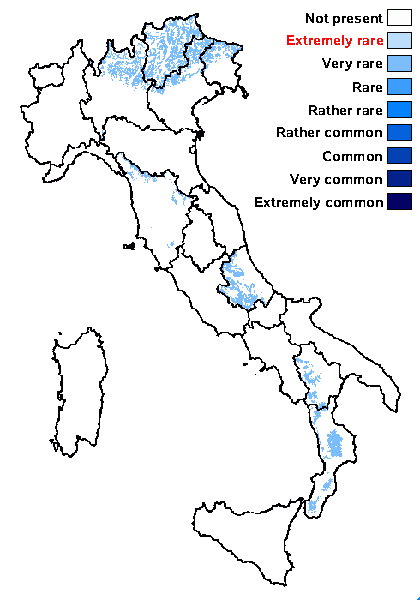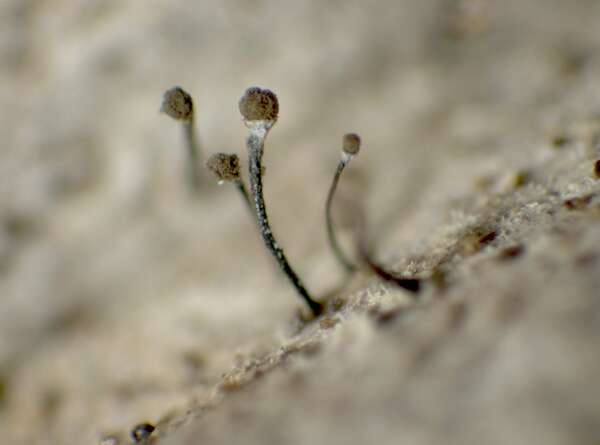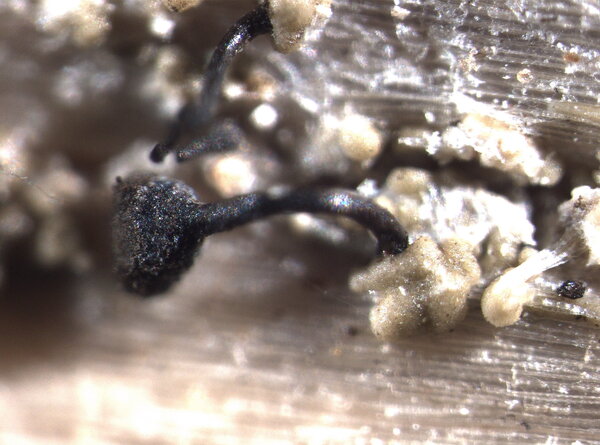Chaenotheca xyloxena Nádv.
Repert. Spec. Nov. Regni Veg., 36: 308, 1934.
Synonyms: Chaenotheca nudiuscula (Schaer.) Nádv.
Distribution: N - Frl (Puntillo & Puntillo 2009), Ven (Thor & Nascimbene 2007, Nascimbene 2008c, Nascimbene & al. 2013b), TAA (Nascimbene & al. 2006e, 2007b, 2922, Puntillo & Puntillo 2009, Nascimbene 2013, Nimis & al. 2015), Lomb (Puntillo & Puntillo 2009). C - Tosc (Benesperi & al. 2007), Abr (Ravera 2002b). S - Bas (Puntillo & Puntillo 2009), Cal (Puntillo 1994, 1996, Puntillo & Puntillo 2009).
Description: Thallus crustose, endosubstratic, poorly evident, sometimes appearing as a greenish or grey stain on the substrate. Apothecia stalked, pin-like, 0.9-1.6 mm high. Stalk slender, shining black in lower part, usually white-pruinose in upper part, consisting of periclinally arranged, medium brown hyphae. Capitulum 0.2-0.3 mm across, obconical, white-pruinose in lower part, with a well-developed, cushion-like excipulum; inner part of excipulum consisting of periclinally arranged hyphae, continuous with the stalk tissue, outer part of swollen, anticlinally arranged hyphae. Mazaedium well-developed, brown; hypothecium obconical, pale brown, with a convex upper surface. Asci short-cylindrical or irregular, formed in chains, dissolving early, with 1-seriate to irregularly arranged ascospores. Ascospores 1-celled, brown to pale brown, globose, 3-4 µm wide, with a smooth to irregularly cracked wall. Photobiont chlorococcoid, with rectangular cells (Stichococcus). Spot tests: thallus K-, C-, KC-, P-. Chemistry: thallus without lichen substances.Note: a cool-temperate to circumboreal-montane species found on hard and dry lignum, especially of conifers, in humid, montane to subalpine forests, more rarely on bark and lignum of deciduous trees, from the Alps to the mountains of Calabria. It is included in the Italian red list of epiphytic lichens as “Near-threatened” (Nascimbene & al. 2013c).
Growth form: Crustose
Substrata: bark and lignum
Photobiont: green algae other than Trentepohlia
Reproductive strategy: mainly sexual
In underhangs rarely wetted by rain
Commonnes-rarity: (info)
Alpine belt: absent
Subalpine belt: very rare
Oromediterranean belt: absent
Montane belt: very rare
Submediterranean belt: absent
Padanian area: absent
Humid submediterranean belt: absent
Humid mediterranean belt: absent
Dry mediterranean belt: absent

Predictive model
Herbarium samples
Growth form: Crustose
Substrata: bark and lignum
Photobiont: green algae other than Trentepohlia
Reproductive strategy: mainly sexual
In underhangs rarely wetted by rain
Commonnes-rarity: (info)
Alpine belt: absent
Subalpine belt: very rare
Oromediterranean belt: absent
Montane belt: very rare
Submediterranean belt: absent
Padanian area: absent
Humid submediterranean belt: absent
Humid mediterranean belt: absent
Dry mediterranean belt: absent

Predictive model
| Herbarium samples |
 Index Fungorum
Index Fungorum
 GBIF
GBIF





